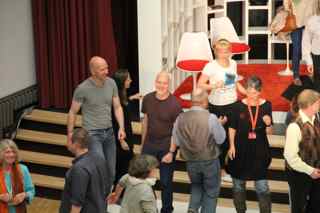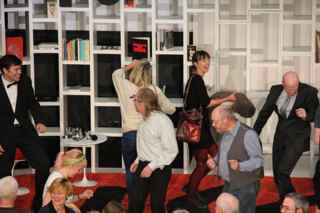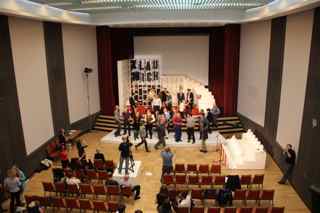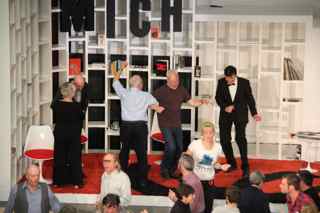OPENING DAY: DIE KLAU MICH SHOW ON JUNE 8 13:50
Dora wrote...
It happened. It came- we opened to a full house on Friday June 8 at 13:50, Ständehaus Kassel, dOCUMENTA(13). Too tired to write much more now, find here the pictures of the GRAND FINALE and some selected moments of the script. Big thanks to everyone: Chaosium, Ellen Blumenstein, Samir Kandil, Jan Mech, Leon Redler and Peter Cross. Thanks to everyone involved. Next: June 15, Goetz Aly- as always, Ständehaus Kassel 13:50- or online live stream at: http://dieklaumichshow.org/stream.html
JUNE 8, script: Wir lieben entartete Kunst
Ladies and Gentlemen, live aus dem Ständehaus in Kassel: die KLAU MICH Show!!!
Heute geht es in der KLAU MICH-Show um:
Metanoia, Gegenkultur, Entartete Kunst, Zerstörung in der Kunst, licence to kill, anti-authority, die gay liberation front, gescheiterte Existenzen, Ablehnung und Angst, radicalism, Deviance und Misinterpretation!
Unsere heutigen Gäste sind: der Autor, Kurator, und counterculture-Kenner Peter Cross; der amerikanische Psychiater Leon Redler sowie – zumindest das Werk – des “letzten politischen deutsche Künstlers”Gustav Metzger.
Ladies and Gentlemen, KLAU MICH!!!
The three presentators come running and warmly salute the THREE audiences in front of them: Chaosium, Ständehaus and TV audience.
Just a little question before we begin: Which documenta was the best documenta up to this one? 1972? documenta5?
yes, according to many, that was up to today the best documenta. For many reasons. An important one, because most of the participants had long hair. But also: for the first time, performance and installation were shown. But most importantly, and here I point to something many of its detractors complained about: “it had almost nothing to do with works of art”
This was of course a matter of discussion, but there were indeed some works displayed no one doubted about: clearly, they were works, that were not of art. Among them, those termed in a classical manner: Bildnerei der Geisteskranken: artistry of the lunatics.
This was the term used by Theodor Spoerri to speak about something unusual: the inclusion of the works of Adolf Wölfli and other artists patients of the Waldau Psychiatric hospital in the exhibition documenta 5.
Spoerri pointed out that strong parallelisms would be drawn between the work of the mentally ill and the 1972 contemporary artists; parallel, but not mixed- the names of Waldau artists patients could not be found in the list of invited artists to documenta 5, “Individual Mythologies”, but remained in the section “artistry of the lunatics” Is this correct? my information comes from the original catalogue.
Someone (Walter Grasskamp, actually) said that documenta5 was the first truly courageous documenta answer to that other pre-II world war-block-buster exhibition: Entartete Kunst. In common they had, as you know, the mixing of “insider” contemporary art with “outsider” artistry of the mentally ill.
Strangely enough, there are other, tragically amusing parallelisms. The derisory texts accompanying the exhibition “entartete kunst” sound still familiar today when talking about contemporary art: “ugly” “incomprehensible” “sick” “made with garbage” but also “paid with the taxes of the German people“.
Parallel indeed, to some of the wording used by Barbara Rose when talking about documenta5 (woman’s voice): “Perhaps the most striking feature of this (1972) year documenta is that it has almost nothing to do with works of art.(…) On the cover (of the catalogue) a swarm of insects calls to mind the putrescence indicative of the death of a culture. This sense of decay is implicit in page after page of evidence of the pathology and alienation of today’s avant-garde. Every kind of abnormal behavior has its place at Documenta: narcissism, megalomania, sadomasochism, necrophilia, etc
(normal voice again) Barbara Rose, New York Magazine, August 1972.
This is what KLAU MICH is about: artists, like madmen, can get away with everything: sexual degeneration, justification of violence, ADVOCATING revolt, social agitation, excusing terrorism, blasphemy, drug dealing… you name it; we do it.
Yes, we can get away with everything… or so we are trying.
Suddenly, to the chaosium audience- What is your favourite kind of art? Chaosium answers, at once and all together: ENTARTETE KUNST! but of course, Degenerate art! Yes!! we love degenerate art!
the three together: wir lieben entartete kunst
Jan: We love degenerate art.
Everyone, singing:
Wir lieben entartete Kunst
Wir lieben entartete Kunst
Wir lieben entartete Kunst
Wir lieben entartete Kunst
Samir, solo: Entartet
all: entartet
Wir lieben entartete Kunst
Ja Kunst
entartet
entartet
Wir lieben entartete Kunst
Tabu: TABU!
This is the first KLAU MICH show, radicalism in society meets experiment on TV,
Our guests define us!! please let me therefore introduce you to the guests of this month of June:
(Chaosium: as in a song, question and answer sequence, the moderator proposes the name, Chaosium answers at one!!!!)
Leon Redler: dialectics of liberation!!!
Gustav Metzger: destruction in art!!!!
Peter Cross: radical art and politics!!!!
Rainer Langhans: Klau mich!!!!
Götz Aly: Unser Kampf!!!
and Art & Language: Corrected Slogans!!!!
And Today: from London, three great, contradictory, paradoxical, countercultural and once underground currents: the radical art of Gustav Metzger; the radical psychiatry and politics represented by the Philadelphia association and American psychiatrist Leon Redler; and the movements of sexual liberation, radical art and politics happening in London, as lived and written about by Peter Cross.
(the guests come in with music and clapping: as they sit, the Chaosium sings like a chorus: Ich bin nog immer, unbefriedigt)







For Klau Mich Blog from Mariella Guzzoni
hallo Dora,
Thank you for the Klau Mich Show!
Franco Basaglia once said, “The artist is whoever leaves his own circle and also reinvents his role in relation to others”. He said this thirty-nine years ago, as documented in the diary of laboratory P, of Friday 12 January 1973, for Marco Cavallo, the blue horse that marked the beginning of a new bond between individuals, “an alternative communication manual.”
15 shows for Documenta, we could call it a journey, another alternative communication manual. I’ll talk about just two of them. The first show of 8 June – to quote Gustav Metzger, “The idea is to destroy things in order to protect the individual” – concluded with a challenge bellowed aloud for all to hear: Destroy things, protect the individual, and here is a question to all of you tonight: what would you destroy in order to protect yourself? This is the challenge you threw down, everyone can do something.
My answer to this challenge – and I thought long and hard about it – is:
DESTROY LABELS TO PROTECT THE INDIVIDUAL
Labels of every type that trivialize without taking anything into account, least of all the individual – but most of all psychiatric labels. Let’s stop the proliferation of labels on people that – increasing the subjection between psychiatrist and patient, move in the opposite direction to the democratization that, as Franco Rotelli tells us, we still so badly need. Labelled people fall into the mass statistics of the ‘mentally disturbed’, yet are ‘precious’ as consumers of psychotic drugs, they are kept in this condition. General consensus identifies this as the only conceivable direction. Of course! It’s the easiest way… with children too. We even have the approval of their mothers (and that’s saying a lot). But who does it benefit? Well it certainly benefits the prescriptive authority, social exclusion, the pharmaceutical industry.
As you know, this summer I went out to pick flowers to paint them onto the patient assessment forms of the old psychiatric department of Villa dei Fiori, (from Imola, “the city of the insane”) that I’d gathered from amongst the ruins in 2010. The department doesn’t exist anymore. Those forms, handwritten in pencil (from the 1970s-80s) are sinister, they’re practically empty. On one side, there are three words: diagnosis label (DSM III-DSM IV) – on the other side cure label: the prescribed drug. NO attention paid to the individual! No personal history, NOTHING. I asked myself, isn’t it strange how these places are often named after flowers, at least in Italy they are, Villa dei Fiorni, Villa Rosa – perhaps to alleviate the conscience of those who don’t want uncomfortable relatives around? But the rubble is useless if the psychiatric prejudice survives!
On the 24 August, I entered the Standelhaus for the twelfth show, (Invented Institutions vs Total Institutions) and here the flickering screen told me:
A psychiatrist and a psychologist inform the audience as they come in, of different psychiatric disorders they might suffer:
Disorder of adult personality and behaviour.
Immediately the screen projects a long list of mental illnesses.
F60 Specific personality disorders – F60.0 Paranoid personality disorder – F60.1 Schizoid personality disorder- F60.3 Emotionally unstable personality disorder-.30 Impulsive type
-.31 Borderline type – F60.4 Histrionic personality disorder (…) – F65 Disorders of sexual
preference (…) – F65.9 Disorder of sexual preference, unspecified (…) – F68 Other disorders of adult personality and behaviour -F69 Unspecified disorder of adult personality and behaviour.
On the scene we see the DSM-Diagnostic and Statistical Manual of Mental Disorders,
first drawn up in 1952 by – guess who – the APA (American Psychiatric Association) in response to the ICD (International Classification of Diseases) of the World Health Organization… (quite a move of appropriation). What began sixty years ago, perhaps with good intentions, that classified, were practical and statistical (Feyerabend would have something to say). In this way, psychiatrists all over the world could speak to each other, manual in hand. Label Listing!
But back to us. The ‘doctors’ of the Chaosium Theatre close their fantastic show with a long list of drugs for the ‘insane’, to cure – “Acute Psychose” is their diagnosis; Zyprexa, Zeldox, Ciatyl… but they conclude as follows: “Besides, the salesman from the pharmaceutical company was here yesterday and we are very well provided with: Solian, Dogmatil, Dipiperon, Seroquel, Taxilan, Neurocil, Truxal, Leponex, Melperon, Adumbran, Loretam, Librium, Xanax…”,
And where is the individual? The individual, if we allow the infernal labelling machine to proceed unopposed, will be hurriedly and even pre-emptively labelled, as a precaution, inundated with drips, destroyed with drugs, in the name of a CURE. Cure. The list of disorders grows, anything can be a disorder. Anything could be a disorder. But what is the true meaning of cure? Cure implies loving thy neighbour, taking care of another. Perhaps not everybody knows that on the new DSM-V (for 2013) there’s a general concern, (and a manifesto against it) – and that the list you showed us will get worse in social and political terms. In all this, note that it is Francis Allen, (head of the DSM-IV work group), and thus an artifice of this machine, who warns us of this new danger: ever lower diagnostic thresholds, and new diagnostic tools, new speculative voices in the conditional. The Open Letter to the DSM-V says: “The putative diagnoses presented in DSM-V are clearly based largely on social norms, with ‘symptoms’ that all rely on subjective judgments, with little confirmatory physical ‘signs’ or evidence of biological causation. The criteria are not value-free, but rather reflect current normative social expectations”. Here’s a quick example: “Risk of psychosis syndrome”. Allen is telling us: beware, the machine I constructed is going crazy! But there is NO political will to stop it. We could say that the DSM is becoming a ‘Total Manual’, a sort of Total Institution. Franco Rotelli explains, for the asylum, yet just as true here, how: “the Total Institution can only be surpassed if there is a marriage of political will and technical will.”
We might ask ourselves: in the name of who and of what? For the good of the ‘sick’? Or for the control of the social norms with the pretext of a cure? Well, over sixty years ago, Dr. Ferdière, staunch advocate of Art Therapy (drawing on the research of Hans Prinzhorn), on one hand encouraged Antonin Artaud to write and draw (he also made him translate literary texts) and invited him to dinner at his house (!), on the other hand he performed electroshock therapy upon him. In the name of therapy, 52 sessions of electroshock therapy were administered. The equipment, completely homemade, was fabricated by Dr. Latremolière, his right-hand man. And as if that weren’t enough, on 25 May 1946 Ferdière had the audacity to write: “I have returned Artaud to social life; and, if nothing else, I have returned Artaud to artistic and poetic creation. Yes, I have the right to affirm, with great serenity and without false modesty, that, if it were not for my treatment, Artaud would have died in sterility and in confusion, and the famous Letters from Rodes and the Van Gogh would never have seen the light of day.” Two years earlier, on the 20th May 1944, Artaud wrote to Ferdière: “The electroshock treatment for me was horrendous suffering. And in my life, I never want to experience such torture again. And I hope that in the future you will avoid using it on me. Each treatment plunged me into a state of terror that lasted hours. I watched each new session approach in desperation, as I knew that one more time I would have lost consciousness, and that I would have seen myself for a whole day suffocate within myself without recognizing myself, knowing perfectly well that I was somewhere, but only God knew where, as though I were ‘dead’.” A lucid Artaud in his legendary “Lettre aux médecins des asiles de fous” had, in essence, anticipated the themes that we find developed in the anti-psychiatry movement of a few decades later.
So, are we just going backwards and forwards? Van Gogh comes to my mind, perhaps more ‘fortunate’ than Artaud, he was cured at Saint-Rémy with the baths… And do you know why he was locked up, considered dangerous, the first time at the hospital of Arles? In their famous petition to the Mayor of Arles, his thirty ‘dear’ neighbours, in order to have him confined, declared that Van Gogh “posed a threat to all, women and children alike.” (He had recently cut off his ear lobe). The petition for the dear Mayor was signed: “Your devoted electors”! Here is the report of the chief of police in Arles at the time, Joseph d’Ornano, of 27 February 1889: “Van Gogh is not yet a danger to public safety but it is feared that he will become it. All the neighbours are afraid (…)” It is feared that he will become it.
I do not see much difference between this and “Risk of psychosis syndrome”! What do you think?
Thank you, Dora, for all your work
Mariella